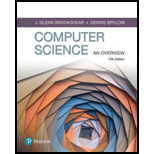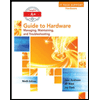
Computer Science: An Overview (13th Edition) (What's New in Computer Science)
13th Edition
ISBN: 9780134875460
Author: Glenn Brookshear, Dennis Brylow
Publisher: PEARSON
expand_more
expand_more
format_list_bulleted
Concept explainers
Textbook Question
Chapter 1.2, Problem 1QE
If the memory cell whose address is 5 contains the value 8, what is the difference between writing the value 5 into cell number 6 and moving the contents of cell number 5 into cell number 6?
Expert Solution & Answer
Learn your wayIncludes step-by-step video

schedule04:55
Students have asked these similar questions
"Do not use AI tools. Solve the problem by hand on paper only and upload a photo of your handwritten solution."
"Do not use AI tools. Solve the problem by hand on paper only and upload a photo of your handwritten solution."
"Do not use AI tools. Solve the problem by hand on paper only and upload a photo of your handwritten solution."
Chapter 1 Solutions
Computer Science: An Overview (13th Edition) (What's New in Computer Science)
Ch. 1.1 - What input bit patterns will cause the following...Ch. 1.1 - In the text, we claimed that placing a 1 on the...Ch. 1.1 - Assuming that both inputs to the flip-flop in...Ch. 1.1 - a. If the output of an AND gate is passed through...Ch. 1.1 - Prob. 5QECh. 1.1 - Prob. 6QECh. 1.2 - If the memory cell whose address is 5 contains the...Ch. 1.2 - Prob. 2QECh. 1.2 - Design a sequence of steps that correctly...Ch. 1.2 - How many bits would be in the memory of a computer...
Ch. 1.3 - Prob. 1QECh. 1.3 - Prob. 2QECh. 1.3 - Prob. 3QECh. 1.3 - Prob. 4QECh. 1.3 - Prob. 5QECh. 1.3 - Prob. 6QECh. 1.4 - Here is a message encoded in ASCII using 8 bits...Ch. 1.4 - In the ASCII code, what is the relationship...Ch. 1.4 - Prob. 3QECh. 1.4 - Prob. 4QECh. 1.4 - Convert each of the following binary...Ch. 1.4 - Prob. 6QECh. 1.4 - What is the largest numeric value that could be...Ch. 1.4 - An alternative to hexadecimal notation for...Ch. 1.4 - What is an advantage of representing images via...Ch. 1.4 - Prob. 10QECh. 1.5 - Convert each of the following binary...Ch. 1.5 - Convert each of the following base ten...Ch. 1.5 - Convert each of the following binary...Ch. 1.5 - Express the following values in binary notation:...Ch. 1.5 - Perform the following additions in binary...Ch. 1.6 - Convert each of the following twos complement...Ch. 1.6 - Prob. 2QECh. 1.6 - Suppose the following bit patterns represent...Ch. 1.6 - Suppose a machine stores numbers in twos...Ch. 1.6 - In the following problems, each bit pattern...Ch. 1.6 - Prob. 6QECh. 1.6 - Prob. 7QECh. 1.6 - Prob. 8QECh. 1.6 - Prob. 9QECh. 1.6 - Prob. 10QECh. 1.6 - Prob. 11QECh. 1.7 - Prob. 1QECh. 1.7 - Prob. 3QECh. 1.7 - Prob. 4QECh. 1.8 - What makes Python an interpreted programming...Ch. 1.8 - Write Python statements that print the following:...Ch. 1.8 - Write Python statements to make the following...Ch. 1.8 - Write a Python statement that given an existing...Ch. 1.9 - Prob. 1QECh. 1.9 - Prob. 2QECh. 1.9 - Prob. 3QECh. 1.9 - Prob. 4QECh. 1.9 - Prob. 5QECh. 1.9 - Prob. 6QECh. 1.9 - Prob. 7QECh. 1.10 - Prob. 1QECh. 1.10 - Could errors have occurred in a byte from Question...Ch. 1.10 - Prob. 3QECh. 1.10 - Prob. 4QECh. 1.10 - Prob. 5QECh. 1.10 - Prob. 6QECh. 1 - Determine the output of each of the following...Ch. 1 - a. What Boolean operation does the circuit...Ch. 1 - a. If we were to purchase a flip-flop circuit from...Ch. 1 - Assume that both of the inputs in the following...Ch. 1 - The following table represents the addresses and...Ch. 1 - How many cells can be in a computers main memory...Ch. 1 - Prob. 7CRPCh. 1 - Prob. 8CRPCh. 1 - Prob. 9CRPCh. 1 - Prob. 10CRPCh. 1 - Suppose a picture is represented on a display...Ch. 1 - Prob. 12CRPCh. 1 - Prob. 13CRPCh. 1 - If each sector on a magnetic disk contains 1024...Ch. 1 - How many bytes of storage space would be required...Ch. 1 - Prob. 16CRPCh. 1 - Prob. 17CRPCh. 1 - Suppose a typist could type 60 words per minute...Ch. 1 - Prob. 19CRPCh. 1 - Prob. 20CRPCh. 1 - Prob. 21CRPCh. 1 - Prob. 22CRPCh. 1 - Prob. 23CRPCh. 1 - Prob. 24CRPCh. 1 - Prob. 25CRPCh. 1 - Prob. 26CRPCh. 1 - Prob. 27CRPCh. 1 - Prob. 28CRPCh. 1 - Prob. 29CRPCh. 1 - Prob. 30CRPCh. 1 - Prob. 31CRPCh. 1 - Prob. 32CRPCh. 1 - Prob. 33CRPCh. 1 - Prob. 34CRPCh. 1 - Prob. 35CRPCh. 1 - Prob. 36CRPCh. 1 - Prob. 37CRPCh. 1 - Prob. 38CRPCh. 1 - Prob. 39CRPCh. 1 - Prob. 40CRPCh. 1 - Prob. 41CRPCh. 1 - Prob. 42CRPCh. 1 - Prob. 43CRPCh. 1 - Prob. 44CRPCh. 1 - Prob. 45CRPCh. 1 - What would be the hexadecimal representation of...Ch. 1 - Prob. 47CRPCh. 1 - Prob. 48CRPCh. 1 - Prob. 49CRPCh. 1 - Prob. 50CRPCh. 1 - Prob. 51CRPCh. 1 - Prob. 52CRPCh. 1 - Prob. 53CRPCh. 1 - Prob. 54CRPCh. 1 - Prob. 55CRPCh. 1 - Prob. 56CRPCh. 1 - Prob. 57CRPCh. 1 - Prob. 58CRPCh. 1 - Write and test a Python script that, given a...Ch. 1 - Prob. 61CRPCh. 1 - Prob. 2SICh. 1 - Prob. 3SICh. 1 - Prob. 4SICh. 1 - Prob. 5SICh. 1 - Prob. 6SICh. 1 - Prob. 7SI
Additional Engineering Textbook Solutions
Find more solutions based on key concepts
Why should a program close a file when its finished using it?
Starting Out with Java: From Control Structures through Objects (7th Edition) (What's New in Computer Science)
This optional Google account security feature sends you a message with a code that you must enter, in addition ...
SURVEY OF OPERATING SYSTEMS
Describe a method that can be used to gather a piece of data such as the users age.
Web Development and Design Foundations with HTML5 (8th Edition)
The switch shown in Fig. P 7.4 has been open for a long time before closing at t = 0.
Figure P7.4
Find io(0−),...
Electric Circuits. (11th Edition)
A class constructor is a member function with the same name as the ________ .
Starting Out with C++: Early Objects (9th Edition)
Show that for circular motion, force = mass * velocity squared/radius.
Thinking Like an Engineer: An Active Learning Approach (4th Edition)
Knowledge Booster
Learn more about
Need a deep-dive on the concept behind this application? Look no further. Learn more about this topic, computer-science and related others by exploring similar questions and additional content below.Similar questions
- "Do not use AI tools. Solve the problem by hand on paper only and upload a photo of your handwritten solution."arrow_forwardSolve this "Do not use AI tools. Solve the problem by hand on paper only and upload a photo of your handwritten solution."arrow_forward"Do not use AI tools. Solve the problem by hand on paper only and upload a photo of your handwritten solution."arrow_forward
- "Do not use AI tools. Solve the problem by hand on paper only and upload a photo of your handwritten solution."arrow_forwardSpecifications: Part-1Part-1: DescriptionIn this part of the lab you will build a single operation ALU. This ALU will implement a bitwise left rotation. Forthis lab assignment you are not allowed to use Digital's Arithmetic components.IF YOU ARE FOUND USING THEM, YOU WILL RECEIVE A ZERO FOR LAB2!The ALU you will be implementing consists of two 4-bit inputs (named inA and inB) and one 4-bit output (named out). Your ALU must rotate the bits in inA by the amount given by inB (i.e. 0-15).Part-1: User InterfaceYou are provided an interface file lab2_part1.dig; start Part-1 from this file.NOTE: You are not permitted to edit the content inside the dotted lines rectangle. Part-1: ExampleIn the figure above, the input values that we have selected to test are inA = {inA_3, inA_2, inA_1, inA_0} = {0, 1, 0,0} and inB = {inB_3, inB_2, inB_1, inB_0} = {0, 0, 1, 0}. Therefore, we must rotate the bus 0100 bitwise left by00102, or 2 in base 10, to get {0, 0, 0, 1}. Please note that a rotation left is…arrow_forwardSolve this "Do not use AI tools. Solve the problem by hand on paper only and upload a photo of your handwritten solution."arrow_forward
- Solve this "Do not use AI tools. Solve the problem by hand on paper only and upload a photo of your handwritten solution."arrow_forward"Do not use AI tools. Solve the problem by hand on paper only and upload a photo of your handwritten solution."arrow_forwardSolve this "Do not use AI tools. Solve the problem by hand on paper only and upload a photo of your handwritten solution."arrow_forward
- Solve this "Do not use AI tools. Solve the problem by hand on paper only and upload a photo of your handwritten solution."arrow_forwardSpecifications: Part-2Part-2: DescriptionIn this part of the lab, we will illuminate two 7-segment displays. You will need to understand 2's Complement todetermine when the input 4-bit binary number corresponds to a negative or positive number. To understand how anLED display works in Digital, please refer to the playWithLED_Display.dig file provided. You should play withdifferent input combinations to see how it influences the LED Display value. In the screenshot below, note how I wasable to generate the display of “3” on the Hex display by lighting up only certain input wires to the unit. Here is a picture of how the different segments light up to produce the different displays: Note in the picture above that we showed displays only from 0-8 since in 4-bit 2s complement representation, 8 is thelargest modulus value you can represent (the range of integers would be -8 to +7).Your circuit in Part-2 must accept a 4-bit 2's complement input {in3, in2, in1, in0} where in3 is the most…arrow_forwardSolve this "Do not use AI tools. Solve the problem by hand on paper only and upload a photo of your handwritten solution."arrow_forward
arrow_back_ios
SEE MORE QUESTIONS
arrow_forward_ios
Recommended textbooks for you
 C++ Programming: From Problem Analysis to Program...Computer ScienceISBN:9781337102087Author:D. S. MalikPublisher:Cengage Learning
C++ Programming: From Problem Analysis to Program...Computer ScienceISBN:9781337102087Author:D. S. MalikPublisher:Cengage Learning C++ for Engineers and ScientistsComputer ScienceISBN:9781133187844Author:Bronson, Gary J.Publisher:Course Technology Ptr
C++ for Engineers and ScientistsComputer ScienceISBN:9781133187844Author:Bronson, Gary J.Publisher:Course Technology Ptr Systems ArchitectureComputer ScienceISBN:9781305080195Author:Stephen D. BurdPublisher:Cengage Learning
Systems ArchitectureComputer ScienceISBN:9781305080195Author:Stephen D. BurdPublisher:Cengage Learning Microsoft Visual C#Computer ScienceISBN:9781337102100Author:Joyce, Farrell.Publisher:Cengage Learning,
Microsoft Visual C#Computer ScienceISBN:9781337102100Author:Joyce, Farrell.Publisher:Cengage Learning, EBK JAVA PROGRAMMINGComputer ScienceISBN:9781337671385Author:FARRELLPublisher:CENGAGE LEARNING - CONSIGNMENT
EBK JAVA PROGRAMMINGComputer ScienceISBN:9781337671385Author:FARRELLPublisher:CENGAGE LEARNING - CONSIGNMENT A+ Guide to Hardware (Standalone Book) (MindTap C...Computer ScienceISBN:9781305266452Author:Jean AndrewsPublisher:Cengage Learning
A+ Guide to Hardware (Standalone Book) (MindTap C...Computer ScienceISBN:9781305266452Author:Jean AndrewsPublisher:Cengage Learning

C++ Programming: From Problem Analysis to Program...
Computer Science
ISBN:9781337102087
Author:D. S. Malik
Publisher:Cengage Learning

C++ for Engineers and Scientists
Computer Science
ISBN:9781133187844
Author:Bronson, Gary J.
Publisher:Course Technology Ptr

Systems Architecture
Computer Science
ISBN:9781305080195
Author:Stephen D. Burd
Publisher:Cengage Learning

Microsoft Visual C#
Computer Science
ISBN:9781337102100
Author:Joyce, Farrell.
Publisher:Cengage Learning,

EBK JAVA PROGRAMMING
Computer Science
ISBN:9781337671385
Author:FARRELL
Publisher:CENGAGE LEARNING - CONSIGNMENT

A+ Guide to Hardware (Standalone Book) (MindTap C...
Computer Science
ISBN:9781305266452
Author:Jean Andrews
Publisher:Cengage Learning
Computer Fundamentals - Basics for Beginners; Author: Geek's Lesson;https://www.youtube.com/watch?v=eEo_aacpwCw;License: Standard YouTube License, CC-BY